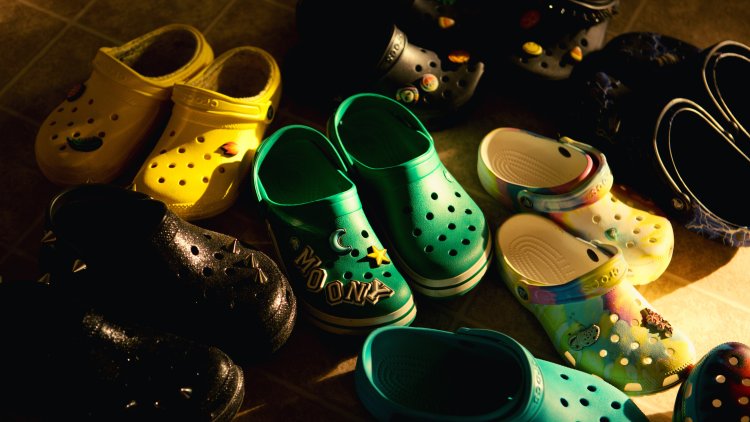How the Ugly Shoe Got Chic
Clog, meet runway.

This is an edition of The Atlantic Daily, a newsletter that guides you through the biggest stories of the day, helps you discover new ideas, and recommends the best in culture. Sign up for it here.
From a young age, I respected the Croc. But somewhere along the way, I got the message that my favorite orange clogs were not chic, and I moved on.
Then, something remarkable happened. After years of being periodically trendy, comfy shoes took off during the early pandemic. Crocs started selling like crazy. Last year, Birkenstock went public. And elite designers have started collaborating with mass-market comfort brands, sometimes festooning their joint creations with ribbons or pearls. A series of such collaborations has emerged over the past few years: Miu Miu x New Balance, Cecilie Bahnsen x Asics, Collina Strada x Ugg, Sandy Liang x Salomon, and Simone Rocha x Crocs, to name a few. Multiple pairs of tricked-up Crocs clogs have appeared on runways lately, and Fendi x Red Wing boots graced the runway at Milan Fashion Week. Birkenstock has collaborated with designers including Jil Sander, Proenza Schouler, and Manolo Blahnik. At this point, nearly every canonical American comfort-shoe brand has paired up with a runway designer.
Yes, many of these shoes are not conventionally beautiful, and that’s part of the fun. The fashion world has a long-standing fascination with ugliness, Emily Huggard, who teaches a class on fashion collaborations at the Parsons School of Design, told me. Designer brands such as Collina Strada and Simone Rocha, both of which have collaborated with mainstream shoemakers, play with themes of grotesquerie and beauty, she noted. Beyond shoes, fashion designers have recently been returning to the grungy, oversize, jagged silhouettes of the 1990s and early 2000s. After a yearslong reign of sleek, minimalist looks, fashion’s extravagantly ugly era is upon us. Ugliness is, of course, subjective: As the fashion critic Vanessa Friedman noted earlier this year, “One person’s ugly shoe is another person’s footwear treasure.”
At least some of high fashion’s interest in working with big comfort-shoe brands is about reaching new audiences. Many of these luxury brands are small—almost certainly not as widely known as mall mainstays such as Crocs and Mephisto. Plus, making a shoe that functions well requires special expertise, which big brands such as Asics and New Balance can provide to smaller, independent collaborators, Thomaï Serdari, a marketing professor at NYU’s business school, told me in an email. From the mainstream brands’ perspective, such collaborations make them seem cool and relevant—and there’s little to lose. As Crocs’ chief marketing officer told The New York Times last year, experimentation isn’t so risky when your shoes are already pretty controversial.
People do actually want to buy some of these shoes: The Simone Rocha x Crocs collaboration, for example, sold out swiftly. The pure shock factor likely helps—Is that a Croc covered in pearls? And because they’re so wacky, such shoes generate rapt, if sometimes quizzical, coverage in fashion magazines. Some shoppers buy the shoes as a way to demonstrate a winking insiderness, or to signal that they’re very online (the collaborations are frequently hits on social media). The high price of high-fashion shoe collaborations may also be part of the appeal. As the Substack newsletter Blackbird Spyplane put it in a September edition about four-figure sneakers, at a time when clothes “seem either criminally cheap or nauseatingly expensive,” $1,500 Loro Piana x New Balance sneakers may be “substantially ‘about’ their own hideous pricetags.”
Not all of these collaborations are unappealing or even in-your-face—those Loro Piana sneakers are pretty subdued—but the mix of high-low is core to the concept. That balance takes skill to pull off. I am personally unlikely to pay hundreds or thousands for a designer version of the shoes I rocked when I was 12. But there’s something undeniably fun about the whimsy, and at times ugliness, of these creations.
Related:
Here are four new stories from The Atlantic:
- The rise of the union right
- Jimmy Carter was a lucky man.
- What the left refused to understand about women’s sports
- 77 facts that blew our minds in 2024
Evening Read
What Not to Wear
By Ellen Cushing
As long as people have been able to dress in color, we’ve been desperate to do it better. In the mid-19th century, advances in dyeing technology and synthetic organic chemistry allowed the textile industry, previously limited to what was available in nature, to mass-produce a rainbow’s worth of new shades. The problem was, people began wearing some truly awful outfits, driven to clashy maximalism by this revolution in color.
The press created a minor moral panic (“un scandale optique,” a French journal called it), which it then attempted to solve. An 1859 issue of Godey’s Lady’s Book, the most widely read American women’s magazine of the antebellum era, promised to help “ill-dressed and gaudy-looking women” by invoking a prominent color theorist, the French chemist Michel-Eugène Chevreul, and his ideas about which colors were most “becoming” on various (presumably white) women.
Chevreul died in 1889, 121 years before Instagram was invented, but had the platform been available to him, I think he would have done very well on it.
Culture Break
Watch. Check out these six acclaimed movies with roughly 90-minute runtimes.
Read. “Case Study,” a short story by Weike Wang:
“Her father is back in the ER. His second time this month. The first was a short stay.”
When you buy a book using a link in this newsletter, we receive a commission. Thank you for supporting The Atlantic.
What's Your Reaction?




















